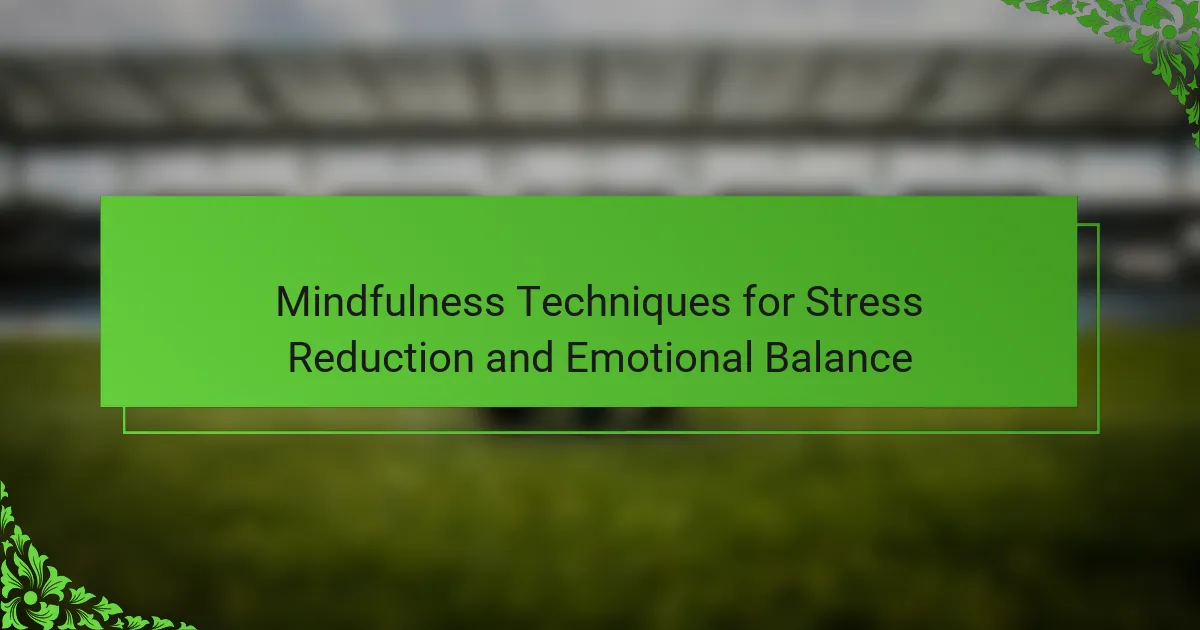Cognitive Behavioral Therapy (CBT) offers effective strategies for improving mental health and coping with challenges. This article explores the principles of CBT, its benefits for anxiety and depression, and various techniques used in therapy. It also addresses common challenges faced by individuals during treatment and highlights available resources for support.
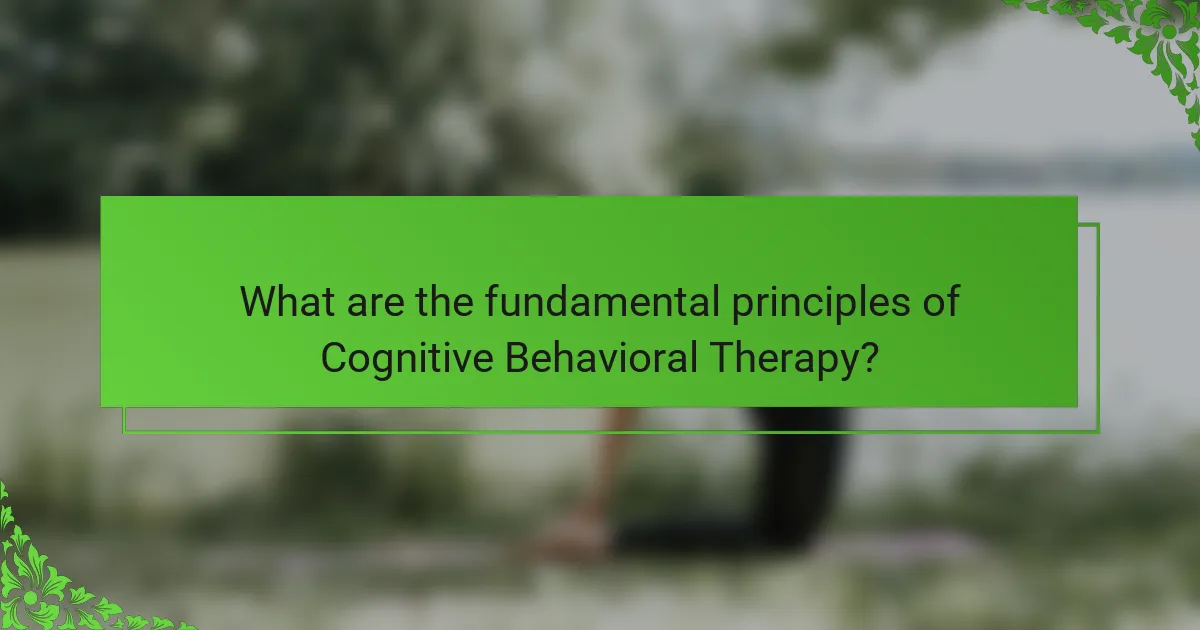
What are the fundamental principles of Cognitive Behavioral Therapy?
Cognitive Behavioral Therapy (CBT) is based on the principles of cognitive restructuring and behavior modification. It emphasizes the connection between thoughts, feelings, and behaviors, aiming to identify and change negative thought patterns to improve emotional regulation and develop coping strategies. Key principles include the collaborative therapeutic relationship, goal setting, and the use of structured techniques to challenge cognitive distortions. These methods enhance self-awareness and promote adaptive behavior, making CBT an effective treatment for various mental health issues.
How does Cognitive Behavioral Therapy differ from other therapeutic approaches?
Cognitive Behavioral Therapy (CBT) focuses on changing negative thought patterns, while other therapies may emphasize emotions or past experiences. CBT is structured and goal-oriented, often involving homework assignments, which distinguishes it from more exploratory approaches. It typically shows quicker results, making it effective for conditions like anxiety and depression. Unlike psychodynamic therapy, which explores unconscious processes, CBT aims for practical skill-building and immediate symptom relief.
What role does the therapeutic relationship play in Cognitive Behavioral Therapy?
The therapeutic relationship is crucial in Cognitive Behavioral Therapy (CBT) as it fosters trust and collaboration. This relationship enhances the effectiveness of techniques used in CBT, such as cognitive restructuring and exposure therapy. A strong therapeutic alliance encourages clients to engage openly, facilitating better identification of negative thought patterns. Research indicates that a positive relationship can significantly improve treatment outcomes, making it a unique attribute of successful CBT practices.
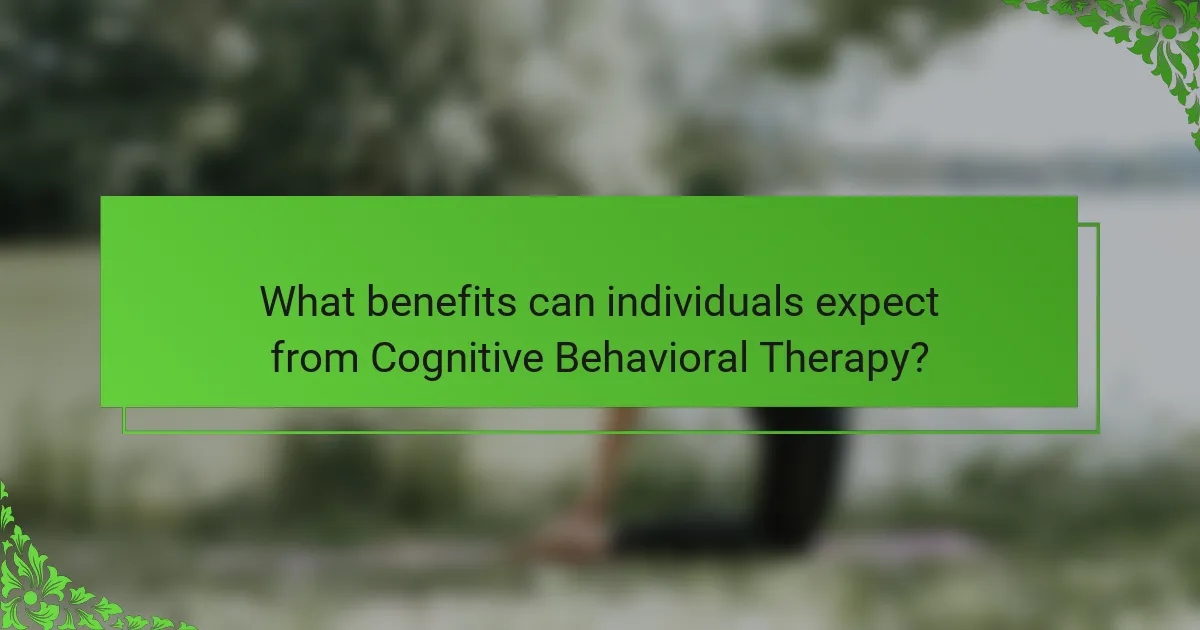
What benefits can individuals expect from Cognitive Behavioral Therapy?
Individuals can expect various benefits from Cognitive Behavioral Therapy (CBT), including improved mental health and coping strategies. CBT effectively reduces symptoms of anxiety and depression by addressing negative thought patterns. It enhances problem-solving skills and promotes emotional regulation, leading to better overall well-being. Additionally, CBT equips individuals with tools to manage stress and improve interpersonal relationships, fostering resilience and long-term mental health.
How does Cognitive Behavioral Therapy address anxiety and depression?
Cognitive Behavioral Therapy (CBT) effectively addresses anxiety and depression by altering negative thought patterns. It equips individuals with practical skills to manage their emotions and behaviors. CBT emphasizes understanding the relationship between thoughts, feelings, and actions, leading to healthier coping mechanisms. Techniques include cognitive restructuring, exposure therapy, and mindfulness practices, which collectively enhance emotional resilience. Additionally, studies show CBT can result in significant symptom reduction, with many individuals experiencing lasting improvements in mental health.
What are the long-term effects of Cognitive Behavioral Therapy on mental health?
Cognitive Behavioral Therapy (CBT) can lead to significant long-term improvements in mental health. Studies show that individuals who undergo CBT often experience lasting reductions in symptoms of anxiety and depression.
CBT equips individuals with coping strategies that promote resilience, enabling them to manage stressors effectively. The skills learned during therapy can foster better emotional regulation and improved interpersonal relationships.
Research indicates that approximately 60-70% of individuals maintain positive outcomes for years after completing CBT. This sustained impact highlights CBT’s effectiveness in creating lasting change in mental health.
Additionally, CBT’s structured approach allows for adaptability, making it applicable to various mental health conditions, including PTSD and OCD. This versatility contributes to its long-term efficacy in enhancing overall well-being.
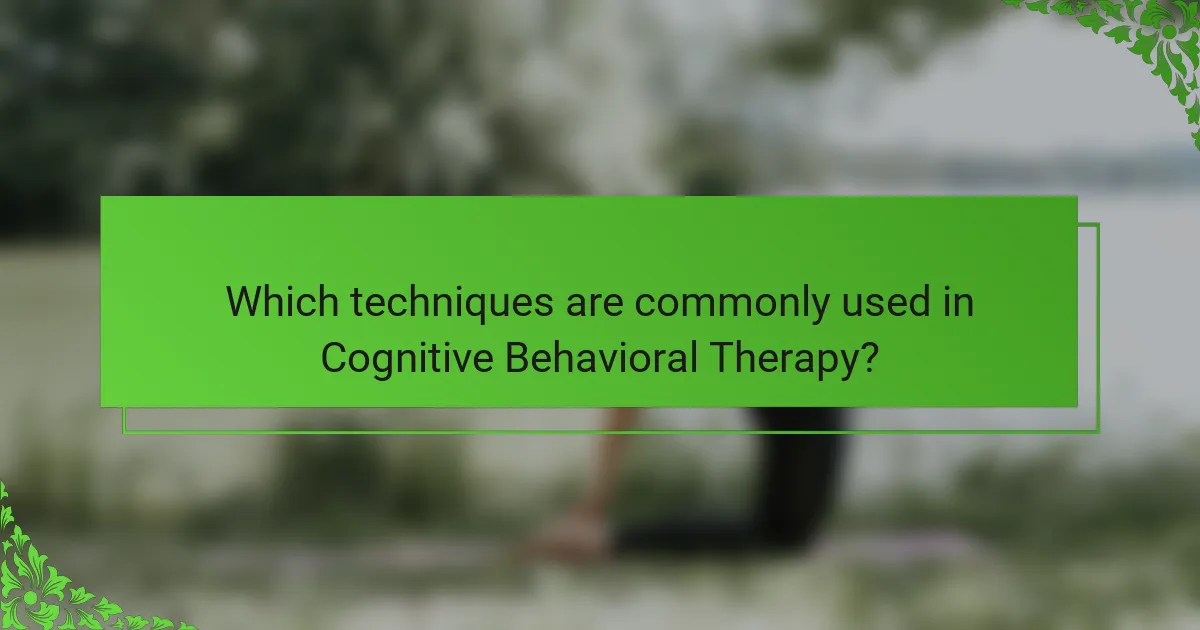
Which techniques are commonly used in Cognitive Behavioral Therapy?
Cognitive Behavioral Therapy commonly employs techniques such as cognitive restructuring, exposure therapy, behavioral activation, and mindfulness. These methods help individuals identify and change negative thought patterns, confront fears, increase engagement in positive activities, and enhance present-moment awareness. Each technique offers unique benefits tailored to improve mental health outcomes.
What is the role of cognitive restructuring in Cognitive Behavioral Therapy?
Cognitive restructuring plays a crucial role in Cognitive Behavioral Therapy (CBT) by helping individuals identify and modify negative thought patterns. This technique enables clients to challenge distorted beliefs, leading to improved emotional responses and behaviors. Cognitive restructuring enhances self-awareness and promotes healthier thinking, which is essential for effective therapy outcomes. Through this process, clients gain tools to reframe their perspectives, ultimately fostering resilience and better coping strategies.
How do exposure techniques function within Cognitive Behavioral Therapy?
Exposure techniques function within Cognitive Behavioral Therapy by helping individuals confront and reduce their anxiety through gradual exposure to feared situations. This method encourages clients to face their fears in a controlled manner, leading to desensitization over time.
Through repeated exposure, clients can learn that their feared outcomes are unlikely to occur, which diminishes their anxiety response. This technique is particularly effective for conditions such as phobias, PTSD, and social anxiety. By incorporating exposure techniques, Cognitive Behavioral Therapy enhances its effectiveness in promoting emotional resilience and coping strategies.
What are behavioral activation strategies in Cognitive Behavioral Therapy?
Behavioral activation strategies in Cognitive Behavioral Therapy (CBT) focus on increasing engagement in meaningful activities to combat depression. These strategies encourage individuals to identify and participate in activities that promote positive emotions and reduce avoidance behaviors. Techniques may include creating a schedule of enjoyable activities, setting achievable goals, and tracking progress. These approaches aim to enhance emotional well-being and improve overall functioning.

How can Cognitive Behavioral Therapy be adapted for different populations?
Cognitive Behavioral Therapy can be adapted for different populations by modifying techniques to fit cultural, developmental, and specific psychological needs. For example, therapy for children may incorporate play therapy techniques, while approaches for older adults might focus on life review and coping with loss. Additionally, culturally sensitive adaptations ensure that the therapy respects and incorporates the values and beliefs of diverse backgrounds. Tailoring interventions enhances engagement and effectiveness across various demographic groups.
What considerations are there for using Cognitive Behavioral Therapy with children?
Using Cognitive Behavioral Therapy (CBT) with children requires careful consideration of their developmental stage and individual needs. Key factors include age-appropriate techniques, parental involvement, and the child’s ability to understand cognitive processes.
Therapists should tailor interventions to match the child’s cognitive level, ensuring concepts are relatable. For example, using play therapy can help younger children engage with CBT principles. Involving parents fosters a supportive environment and reinforces skills learned in therapy.
Cultural sensitivity is vital, as children’s backgrounds influence their perceptions and responses. Additionally, monitoring progress and adapting strategies is essential for effective outcomes. Overall, a personalized approach enhances the efficacy of CBT in children.
How is Cognitive Behavioral Therapy applied in group settings?
Cognitive Behavioral Therapy (CBT) is effectively applied in group settings by fostering shared experiences and support among participants. This approach enhances individual learning through group discussions and collective problem-solving.
In group therapy, CBT techniques like cognitive restructuring and behavioral activation are utilized to address common issues. Participants can practice skills in real-time, receive feedback, and learn from others’ experiences. The group dynamic also promotes accountability and motivation, as members encourage each other to implement strategies outside of sessions.
Group CBT often includes structured sessions that focus on specific themes, such as anxiety or depression. This targeted approach allows for in-depth exploration of issues while providing a safe space for sharing. As a result, participants often report increased self-awareness and improved coping skills.
The unique attribute of group CBT is the sense of community it creates, which can significantly enhance the therapeutic process. Research indicates that group therapy can lead to similar outcomes as individual therapy, making it a valuable option for many seeking support.
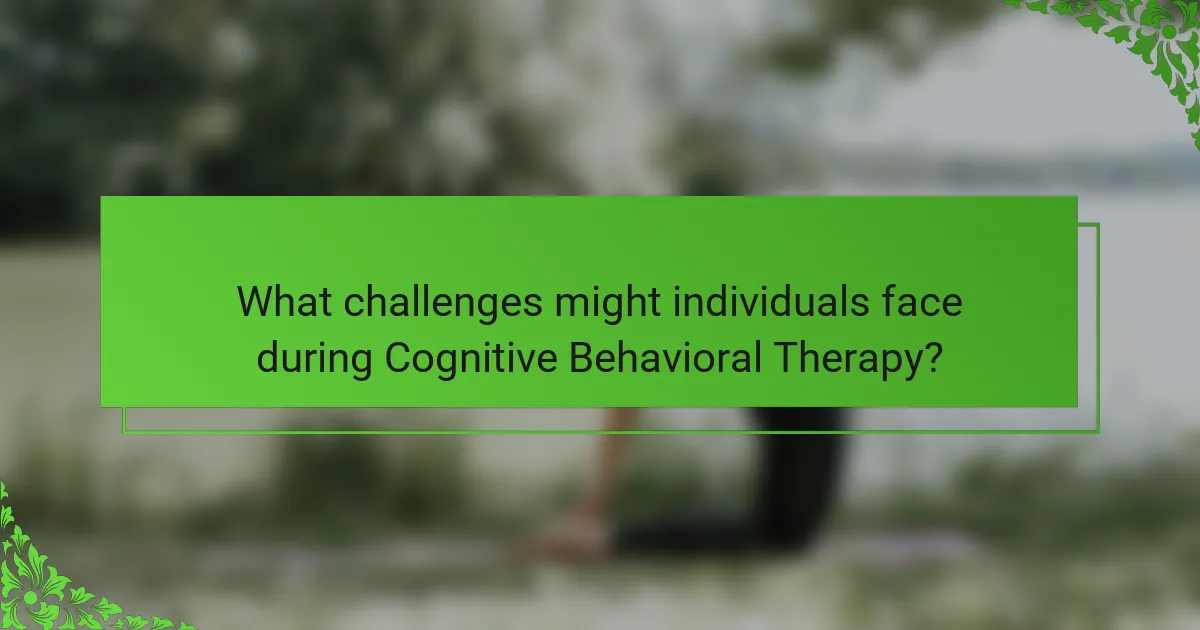
What challenges might individuals face during Cognitive Behavioral Therapy?
Individuals may face several challenges during Cognitive Behavioral Therapy. Common issues include emotional discomfort, resistance to change, and difficulty in identifying negative thought patterns.
Emotional discomfort often arises as individuals confront painful memories or experiences. Resistance to change can manifest as reluctance to adopt new behaviors or thoughts. Additionally, some may struggle to recognize and articulate their negative thought patterns, complicating the therapeutic process.
Therapists often address these challenges through supportive techniques and gradual exposure, helping clients navigate their emotions while fostering resilience.
How can clients overcome resistance to Cognitive Behavioral Therapy?
Clients can overcome resistance to Cognitive Behavioral Therapy by building trust, setting realistic goals, and engaging in open communication. Establishing a strong therapeutic alliance fosters a safe environment. Clients should identify specific fears or misconceptions about therapy, allowing for tailored discussions. Encouraging gradual exposure to techniques can help clients feel more comfortable. Regularly reviewing progress reinforces motivation and commitment to the therapeutic process.
What are common misconceptions about Cognitive Behavioral Therapy?
Cognitive Behavioral Therapy is often misunderstood. Common misconceptions include the belief that it is only for severe mental health issues, that it is a quick fix, and that it solely focuses on the past. Many think it requires extensive time commitments, while in reality, it can be effective in a shorter duration. Additionally, some people believe it eliminates all negative thoughts, but it actually teaches individuals to manage and reframe them.
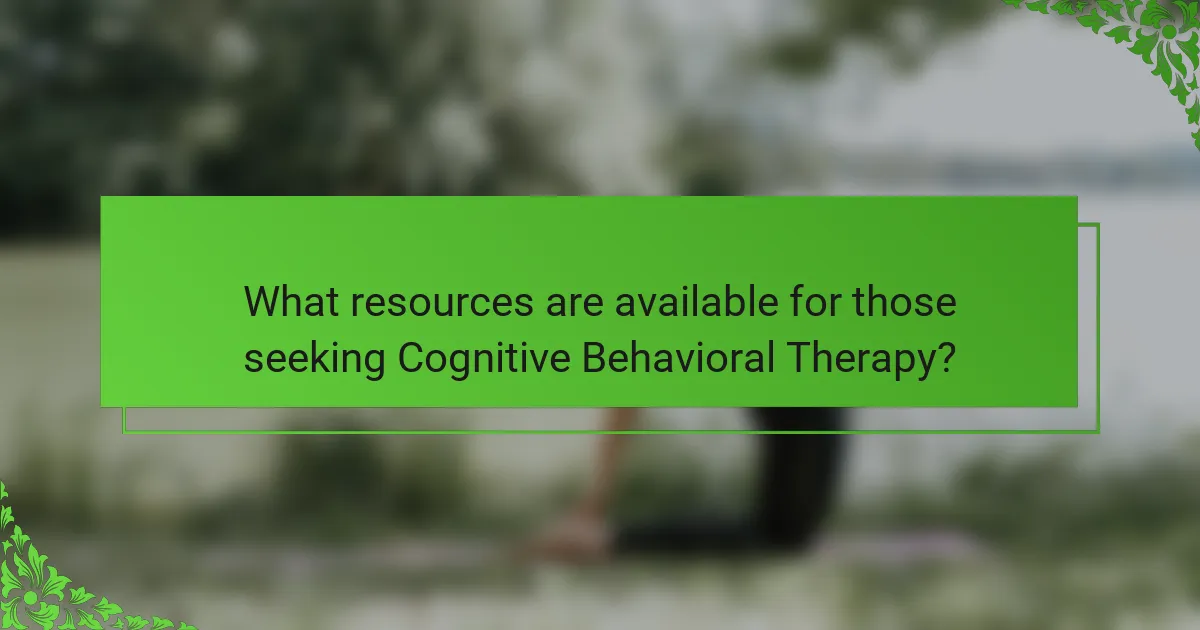
What resources are available for those seeking Cognitive Behavioral Therapy?
Various resources are available for individuals seeking Cognitive Behavioral Therapy (CBT). These include licensed therapists, online platforms, self-help books, support groups, and mobile apps designed to assist in CBT practices.
Therapists provide personalized guidance and structured sessions. Online platforms like BetterHelp and Talkspace offer remote therapy options. Self-help books, such as “Feeling Good” by David Burns, deliver CBT techniques for independent practice. Support groups foster community and shared experiences. Mobile apps like Woebot and Moodfit offer tools and exercises based on CBT principles.
How can individuals find qualified Cognitive Behavioral Therapy practitioners?
Individuals can find qualified Cognitive Behavioral Therapy practitioners through several effective methods. Start by checking professional directories such as the American Psychological Association or the National Association of Cognitive-Behavioral Therapists. These platforms list licensed professionals with specific training in CBT.
Additionally, consider seeking referrals from primary care physicians or mental health professionals who can recommend trusted practitioners. Online platforms that connect patients with therapists, such as BetterHelp or Talkspace, often allow filtering for CBT specialists.
Lastly, verify credentials and read reviews on platforms like Psychology Today to ensure the practitioner’s qualifications and approach align with personal needs.
What are the best practices for maximizing the effectiveness of Cognitive Behavioral Therapy?
To maximize the effectiveness of Cognitive Behavioral Therapy, establish clear goals, maintain a consistent schedule, and actively engage in homework assignments.
1. Set specific, measurable, achievable, relevant, and time-bound (SMART) goals to guide therapy.
2. Attend sessions regularly to build momentum and reinforce learning.
3. Complete assigned tasks between sessions to practice techniques and reinforce skills.
4. Foster open communication with the therapist to address challenges and adjust strategies.
5. Utilize cognitive restructuring techniques to identify and challenge negative thought patterns.
6. Incorporate mindfulness practices to enhance self-awareness and emotional regulation.



